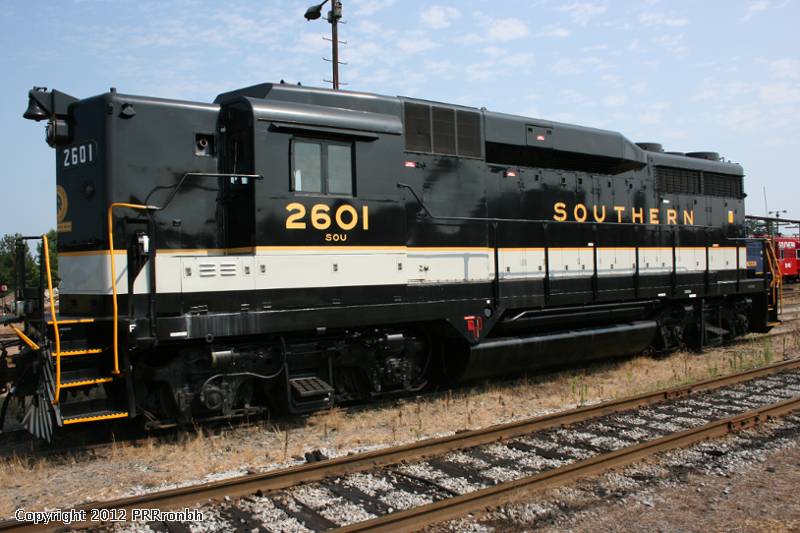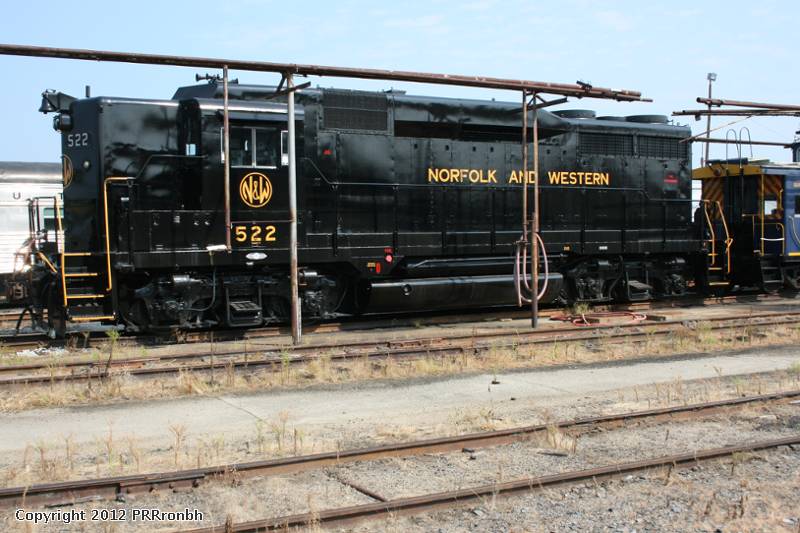PRRronbh posted:What GP30's should look like!
Darn right!
I never met a GP30 I didn't like, even a CSX slug................
Attachments
Here in the Pacific Northwest, you run into a lot of older diesels. I still see GP30s on the high iron every now and then.
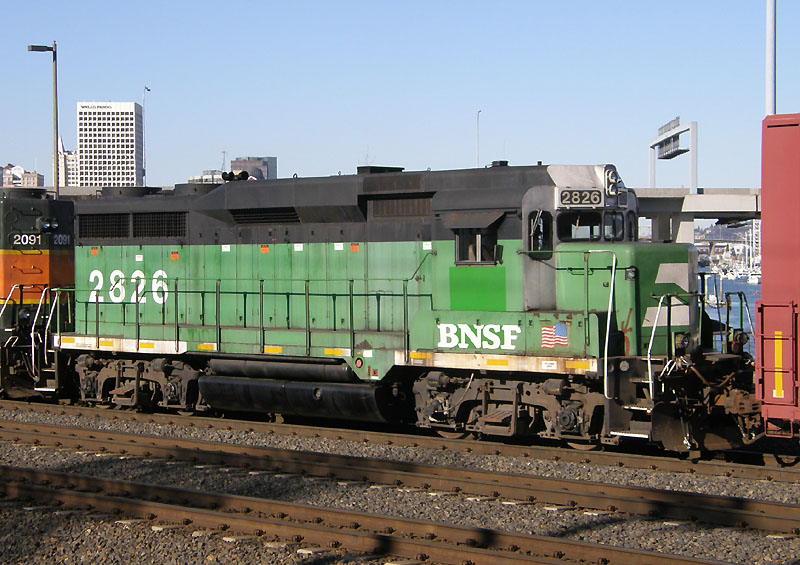
p51 posted:PRRronbh posted:What GP30's should look like!
Darn right!
Seeing this reminded me that when Lionel released these in O-Gauge.
I added them to the roster.
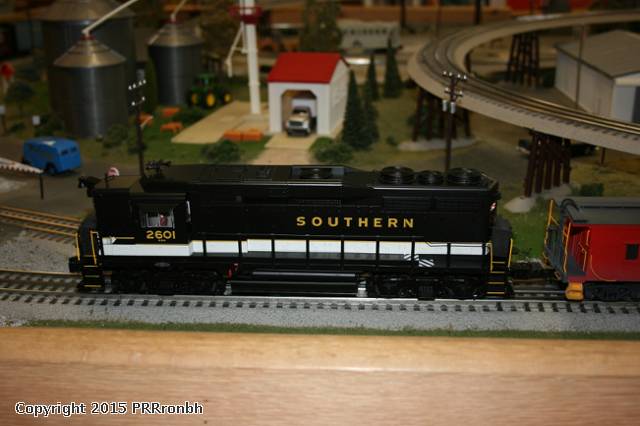
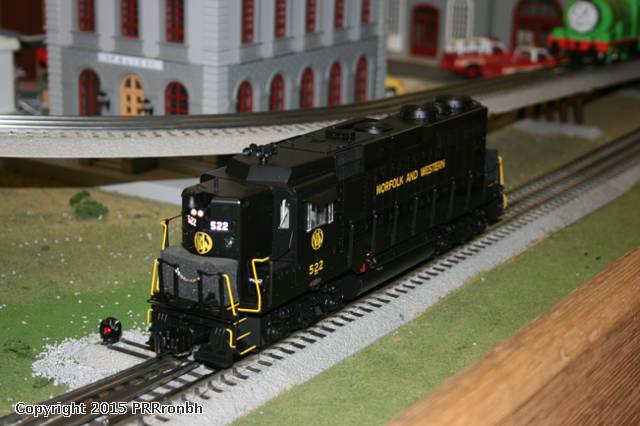
Ron
p51 posted:PRRronbh posted:What GP30's should look like!
Darn right!
Nonsense... This is how GP30's were meant to look.
Rusty
Attachments
I remember that in the early/mid 1960's when the B&O was just about finished daylighting many tunnels on the routes to St. Louis and Chicago, an order was delivered from EMD for 77 GP-30s. Wow they really looked neat with the sunburst logo on the nose. At the same time 3 pairs of hotshot piggyback freights were established from Jersey City, NJ via CNJ-RDG-B&O...Potomac, St. Louisian and the Chicagoan westbound from Jersey City and the Hudson, New Yorker Trailer Jet and the Manhattan Trailer Jet. These trains were the fastest freights operating at that time on the Jersey Central.
(All photos from Fallen Flags website)
Enjoy.
Walter M. Matuch
Attachments
The National Capital Trackers have had a Layout in the B&O Museum for a couple of decades at Christmas. This year, I was running a pair of B&O GP-30s and went out for a cab ride (perk of being a Tracker) in the museum train. I was very surprised that it was the same loco and same paint scheme as I was running inside.
What a great day!
Attachments
Not a fan of the yellow frame stripe on the as delivered Reading and Lionel GP-30
Apparently the Reading didn’t care for it either as they repainted the lower sides of their GP-30’s green very early in their careers
Found a green paint that was pretty much a perfect match to Lionels
Very happy with the way this came out
Thanks
Attachments
dorfj2 posted:Not a fan of the yellow frame stripe on the as delivered Reading and Lionel GP-30
Apparently the Reading didn’t care for it either as they repainted the lower sides of their GP-30’s green very early in their careers
Found a green paint that was pretty much a perfect match to Lionels
Very happy with the way this came out
Thanks
Looks great! Can’t tell it’s not factory painted!
Attachments
How many others worked on GP30's and had to cut out a traction motor by using the little plastic flag on a power contractor? I always made sure to remove anything metallic before sticking my hand down there.
GP30 is a favorite of mine also. I have a Conrail Legacy pair, a pair of Santa Fe MTH, and an MTH Chessie System B&O.
Did any of those high hood NW & SOU units make to the NS era?
VistaDomeScott posted:GP30 is a favorite of mine also. I have a Conrail Legacy pair, a pair of Santa Fe MTH, and an MTH Chessie System B&O.
Did any of those high hood NW & SOU units make to the NS era?
Yes the high hood GP30s did survive in to the NS era.
Neal Jeter
Attachments
Attachments
@Swafford posted:
And so, after all these years, this has finally come to pass.
Many thanks to Steve Nelson (Mr. Muffin) and Lionel for the special run!
I had not thought about this for years, but this topic prompted my aging brain to conjure up some memories. GP30's were the first Santa Fe units from EMD that were built with centralized air filtration and pressurized carbody. The idea was that slight pressurization would keep dust and dirt outside, and, normally, it had a positive effect.
However, if the filters became clogged, the fan still took in air from wherever it could obtain it, and the cab compartment appeared to be ideal for this. In winter, when a GP30's filters needed to be changed or cleaned, the cab heaters could hardly make any difference. I have seen my breath in the cab on more than one occasion. Imaging ascending Cajon Pass for over an hour, in Run-8, with the centralized air filtration fan sucking winter air into the locomotive via the cab. Brrrr.
No photos but I have a pair of O scale NJ Custom Brass GP30s with Central Locomotive Works drives painted in my Eastern Maryland colors.
I also have a "what-if" HO scale SD30 shell created out of a pair of Bachmann GP30 shells and designed to fit on an Atlas SD35 chassis; someday I just might get around to completing it:
Not to mention a "Super 30", note the "Hi-Ad" trucks:
At some point in time, the flared radiator section from an SD45 will be added to the Super 30 although I will use a different shell, I like the Sunburst scheme too much to ruin the B&O shell.
Attachments
GP30s do look pretty cool with the hump above the roof. I actually got to drive the UP #844 GP30 at the Nevada Southern Railway Museum in Boulder City, Nevada about 11 years ago for my 18th birthday. Wow! What an awesome experience, which I would absolutely recommend to any train fans. I just went to the museum recently to just ride the train. Lionel made the GP30 #844 a while back with TMCC, but I am really hoping they will re-release the engine again with Legacy control. I will totally buy it and some matching freight cars (preferably in a set). I may get one of the new BNSF Patched GP30s from Lionel, but I really want the #844 GP30.
@Number 90 posted:I had not thought about this for years, but this topic prompted my aging brain to conjure up some memories. GP30's were the first Santa Fe units from EMD that were built with centralized air filtration and pressurized carbody. The idea was that slight pressurization would keep dust and dirt outside, and, normally, it had a positive effect.
However, if the filters became clogged, the fan still took in air from wherever it could obtain it, and the cab compartment appeared to be ideal for this. In winter, when a GP30's filters needed to be changed or cleaned, the cab heaters could hardly make any difference. I have seen my breath in the cab on more than one occasion. Imaging ascending Cajon Pass for over an hour, in Run-8, with the centralized air filtration fan sucking winter air into the locomotive via the cab. Brrrr.
A few GP30 memories.
I can recall numerous trips across the flatlands of Northern Ohio and Indiana in the late 70's and early 80's, rolling along through the countryside with a GP30 in the lead at 50-60 MPH, and operating through some of Mother Nature's harshest, most brutal winter conditions she could muster up in the Great Lakes Region. A common practice among crew members, was to soak the Scott C-Fold paper towels that the company supplied in water, then place them around the window and door seals of the cab. The frigid winter air being pulled into the cab would quickly freeze the wet paper towels in place, forming a much tighter weather seal, thereby keeping the cab a little more comfortable.
When I hired out in 1977, Chessie's (B&O/C&O) were 15 years old. The old heads still referred to them as "Cadillacs". Opinions differed as to how they acquired that nickname. Some said it was due to their unique styling reminiscent of GM automobiles, others attributed it to the somewhat larger, more spacious cab the GP30 had when compared with previous GP series road switchers. As with many things on the railroad, it was probably a combination of both.
I also recall that if you had one anywhere in your locomotive consist, you had to be mindful of it, especially when starting your train. More often that not, if any locomotive was going to experience a wheel slip, it would be the GP30(s). As they aged, their many stages of transition became more and more troublesome. By the early to mid 80's, many were rebuilt into GP30m's while others became road slugs and served many more years. In spite of these traits, overall they were a pretty good locomotive when functioning properly.
C.J.
Somehow I missed riding in the cab of a GP30, though CNW had 'em and I saw them out on the road, periodically. However, all but the newest SD40s and SD45s had the same leaky door seal issues enumerated above. Once you had a pretty good seal, made with frozen paper towels, the door had to be opened for work to be done and the process of sealing began again. It became a futile effort but it gave the Fireman something to do.
@Number 90 posted:How many others worked on GP30's and had to cut out a traction motor by using the little plastic flag on a power contractor? I always made sure to remove anything metallic before sticking my hand down there.
In a similar situation, we had an ex-CB&Q GP30 as a second unit that would not actuate the sander from the headend. I had to go back and work it manually up a long grade on a rainy day in Oklahoma.
These locomotives remind me of Toyota pickups which will eventually wear down to a point where every feature becomes non-functional, yet they will still start and run all day long.
Attachments
I love GP30's, I love Chessie, and most of all I love early CSX. So the new Lionel GP30's were a no brainer to me. I renumbered mine to 4200 and added a few extra details such as a side mounted bell and air vent on the cab as well as a few paint mods to model a "GP30M", or a unit that underwent a Chessie rebuild program in the early 80's. Then a moderate weathering.
Attachments
What's up with the step and pilot mis alignment on the latest Legacy release?
@ES44AC posted:I love GP30's, I love Chessie, and most of all I love early CSX. So the new Lionel GP30's were a no brainer to me. I renumbered mine to 4200 and added a few extra details such as a side mounted bell and air vent on the cab as well as a few paint mods to model a "GP30M", or a unit that underwent a Chessie rebuild program in the early 80's. Then a moderate weathering.
I did the same; adding a side mounted bell...

Thanks!
- Mario
They are still being produced in limited numbers.




